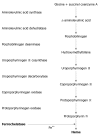Liver disease and erythropoietic protoporphyria: a concise review
- PMID: 20857522
- PMCID: PMC2945483
- DOI: 10.3748/wjg.v16.i36.4526
Liver disease and erythropoietic protoporphyria: a concise review
Abstract
The porphyries are a group of metabolic disorders characterized by deficiencies in the activity of enzymes involved in the biosynthesis of heme. In erythropoietic protoporphyria (EPP), in the majority of cases an autosomal dominant disease, there is a mutation of the gene that encodes ferrochelatase (FECH). FECH deficiency is associated with increased concentrations of protoporphyrin in erythrocytes, plasma, skin and liver. The prevalence of this inherited disorder oscillates between 1:75 000 and 1:200 000. Clinical manifestations of EPP appear in early infancy upon first exposure to the sun. Nevertheless, approximately 5%-20% of patients with EPP develop liver manifestations. Retention of protoporphyrin in the liver is associated with cholestatic phenomena and oxidative stress that predisposes to hepatobiliary disease of varying degrees of severity, such as cholelithiasis, mild parenchymal liver disease, progressive hepatocellular disease with end-stage liver disease and acute liver failure. Liver damage is the major risk in EPP patients, so surveillance and frequent clinical and biochemical liver follow-up is mandatory. The diagnostic approach consists in detecting increased levels of protoporphyrin, decreased activity of FECH and genetic analysis of the FECH gene. A variety of non-surgical therapeutic approaches have been adopted for the management of EPP associated with liver disease, but none of these has been shown to be unequivocally efficacious. Nevertheless, some may have a place in preparing patients for liver transplantation. Liver transplantation does not correct the constitutional deficiency of FECH. Consequently, there is a risk of recurrence of liver disease after liver transplantation as a result of continuing overproduction of protoporphyrin. Some authors recommend that bone marrow transplantation should be considered in liver allograft recipients to prevent recurrence of hepatic disease.
Figures
Similar articles
-
Erythropoietic protoporphyria.Orphanet J Rare Dis. 2009 Sep 10;4:19. doi: 10.1186/1750-1172-4-19. Orphanet J Rare Dis. 2009. PMID: 19744342 Free PMC article. Review.
-
Erythropoietic Protoporphyria and X-Linked Protoporphyria: pathophysiology, genetics, clinical manifestations, and management.Mol Genet Metab. 2019 Nov;128(3):298-303. doi: 10.1016/j.ymgme.2019.01.020. Epub 2019 Jan 24. Mol Genet Metab. 2019. PMID: 30704898 Free PMC article. Review.
-
Clinical, Biochemical, and Genetic Characterization of North American Patients With Erythropoietic Protoporphyria and X-linked Protoporphyria.JAMA Dermatol. 2017 Aug 1;153(8):789-796. doi: 10.1001/jamadermatol.2017.1557. JAMA Dermatol. 2017. PMID: 28614581 Free PMC article.
-
Neonatal bone marrow transplantation prevents liver disease in a murine model of erythropoietic protoporphyria.J Hepatol. 2011 Jul;55(1):162-70. doi: 10.1016/j.jhep.2010.09.029. Epub 2010 Oct 23. J Hepatol. 2011. PMID: 21145811
-
Genetic study in a Singaporean patient with erythropoietic protoporphyria.Photodermatol Photoimmunol Photomed. 2012 Oct;28(5):269-71. doi: 10.1111/j.1600-0781.2012.00685.x. Photodermatol Photoimmunol Photomed. 2012. PMID: 22971195
Cited by
-
Erythropoietic protoporphyrias: Pathogenesis, diagnosis and management.Liver Int. 2025 Jan;45(1):e16027. doi: 10.1111/liv.16027. Epub 2024 Jul 16. Liver Int. 2025. PMID: 39011756 Free PMC article. Review.
-
Human PXR modulates hepatotoxicity associated with rifampicin and isoniazid co-therapy.Nat Med. 2013 Apr;19(4):418-20. doi: 10.1038/nm.3104. Epub 2013 Mar 10. Nat Med. 2013. PMID: 23475203 Free PMC article.
-
Liver metabolomics in a mouse model of erythropoietic protoporphyria.Biochem Pharmacol. 2018 Aug;154:474-481. doi: 10.1016/j.bcp.2018.06.011. Epub 2018 Jun 12. Biochem Pharmacol. 2018. PMID: 29906468 Free PMC article.
-
Target-centric analysis of hepatitis B: identifying key molecules and pathways for treatment.Sci Rep. 2024 Nov 6;14(1):26858. doi: 10.1038/s41598-024-76567-8. Sci Rep. 2024. PMID: 39500944 Free PMC article.
-
Cockayne syndrome group A and ferrochelatase finely tune ribosomal gene transcription and its response to UV irradiation.Nucleic Acids Res. 2021 Nov 8;49(19):10911-10930. doi: 10.1093/nar/gkab819. Nucleic Acids Res. 2021. PMID: 34581821 Free PMC article.
References
-
- Magnus IA, Jarrett A, Prankerd TA, Rimington C. Erythropoietic protoporphyria. A new porphyria syndrome with solar urticaria due to protoporphyrinaemia. Lancet. 1961;2:448–451. - PubMed
-
- Moore MR. Biochemistry of porphyria. Int J Biochem. 1993;25:1353–1368. - PubMed
-
- Ventura P, Cappellini MD, Rocchi E. The acute porphyrias: a diagnostic and therapeutic challenge in internal and emergency medicine. Intern Emerg Med. 2009;4:297–308. - PubMed
-
- Meerman L. Erythropoietic protoporphyria. An overview with emphasis on the liver. Scand J Gastroenterol Suppl. 2000:79–85. - PubMed
-
- Richard E, Robert-Richard E, Ged C, Moreau-Gaudry F, de Verneuil H. Erythropoietic porphyrias: animal models and update in gene-based therapies. Curr Gene Ther. 2008;8:176–186. - PubMed
Publication types
MeSH terms
Substances
LinkOut - more resources
Full Text Sources
Medical


